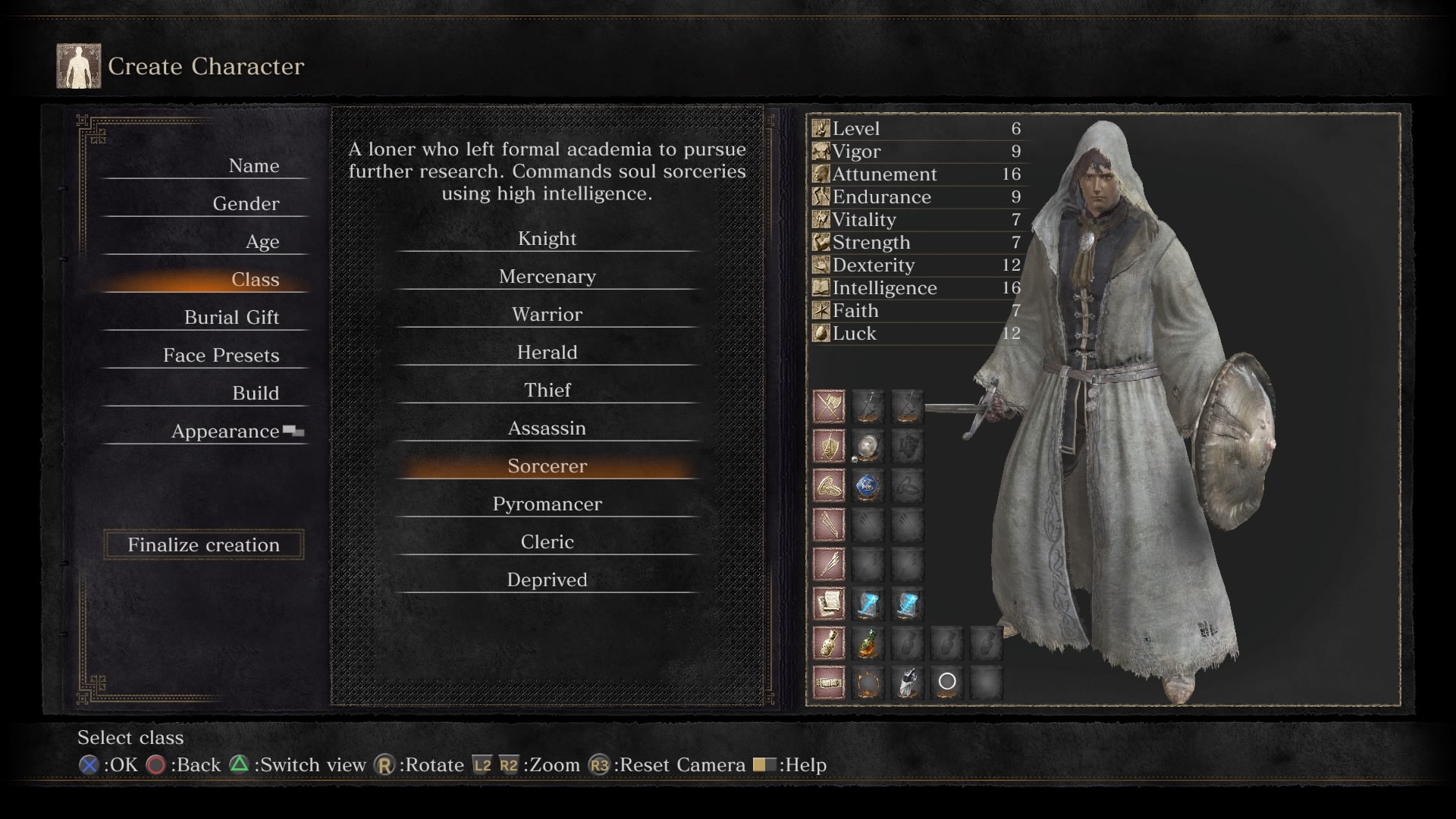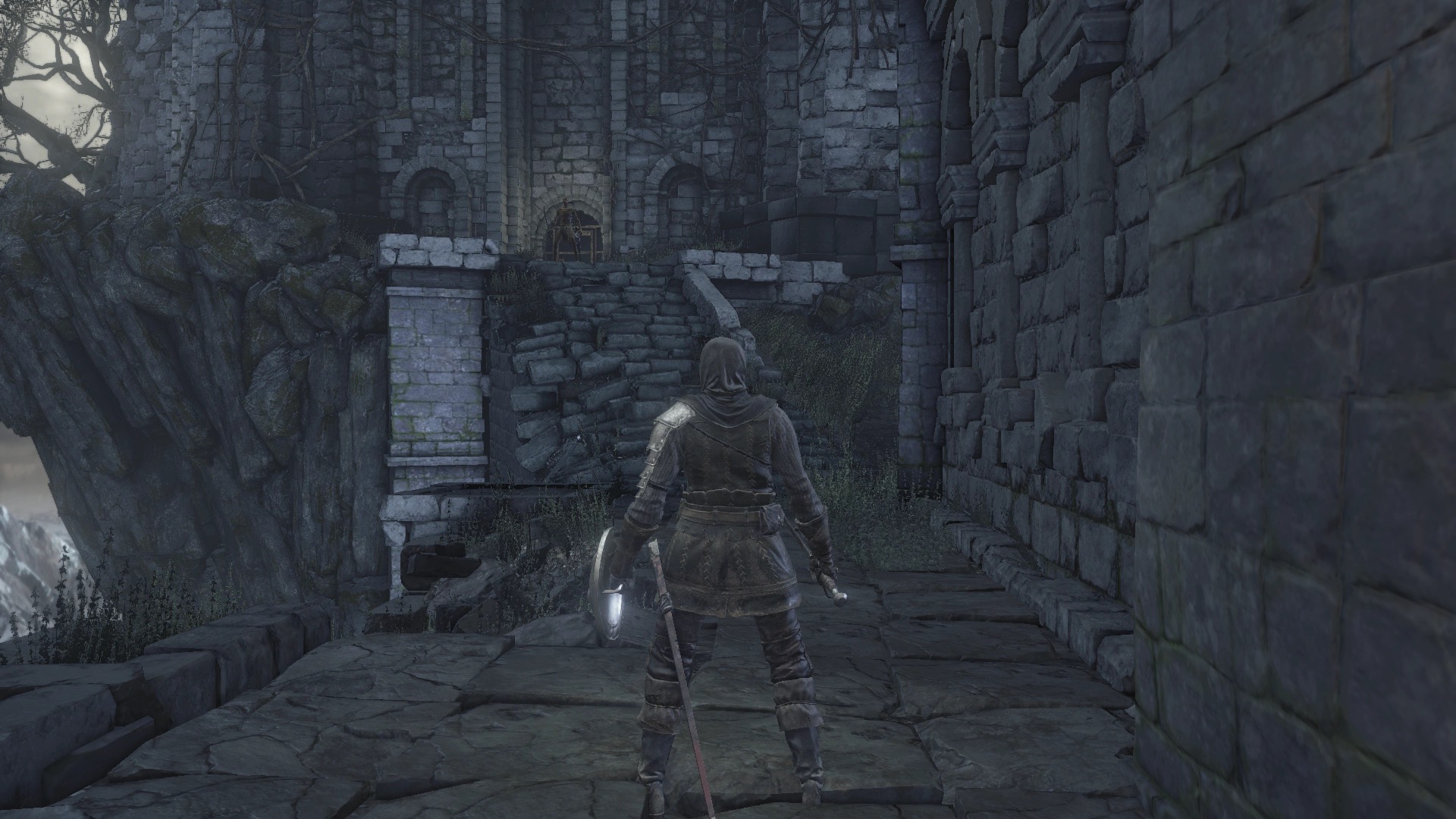
Dark Souls 3 has the advantage. Our beginner’s guide is designed to change that.
Of course, in any Dark Souls game, part of the fun is the challenge, and we’re not here to take that away form you. We’ve designed this document to teach you the language of Dark Souls 3 — and the faster you become fluent, the better.
We’re here to help you understand classes, tie-breaking, new systems, leveling and more — including how we made the best character we’ve ever made in a Dark Souls game (and you can, too).
Contents
- 1 CREATE THE RIGHT CHARACTER FOR YOUR STYLE
- 2 A STRATEGY FOR LEVELING UP
- 3 BREAK A TIE WITH WEAPONS
- 4 BREAK THE RULES WHEN YOU FALL IN LOVE
- 5 TREAT DARK SOULS 3 LIKE IT’S A RHYTHM GAME
- 6 GOODBYE HUMANITY, HELLO KINDLING
- 7 NEVER FIGHT MORE THAN ONE ENEMY AT ONCE
- 8 FIND YOUR LOOP
- 9 SUGGESTED BUILD: THE STRONG SORCERER
CREATE THE RIGHT CHARACTER FOR YOUR STYLE
Like so many role-playing games, Dark Souls 3 divides its characters into classes. Many of the character classes will look familiar to Dark Souls veterans, but a few new classes infiltrated the character creation screen.
Regardless of what you choose, biggest differences between any of the starting classes are the points pre-poured into their various attributes. Even the gear you begin with is little more than an affirmation of those stats.
Sorcerers, for example, have a bunch of points allocated to Intelligence, which makes sense since you need a bunch of that to cast spells. Knights have relatively low Intelligence, but they have more Strength than anything else, which is what you’d want if you’re planning on swinging around heavy weapons while wearing thick armor. A Thief, on the other hand, has a lot of Dexterity and Vigor, perfect for swinging the hell out of little, light weapons. You can check out a gallery of the starting classes below to get a look at them and their stats, too.
Broadly speaking, you may want to fight up close, from a distance or combine the two.
If you’re a brawler, choose a Knight. If you prefer to fight from a distance, choose a Sorcerer. If you’d like a balance between the two, the Pryomancer is a good choice. If you want to be nimble, rolling in and out of risky fights, then a Thief is up your alley. If you’re up for an even bigger challenge but you want to custom-build your character, go with Deprived.
You can gain an enormous advantage early in the game by building a non-traditional Sorcerer. It’s something we recommend, and we’ll talk about below. For now, you can also look at the starting stats in a purely numeric view.
A STRATEGY FOR LEVELING UP
OK. You’ve chosen your class. Now what?
Every character levels up, becoming stronger as you allocate points at will into nearly a dozen attributes.
Leveling up works as it always has in Souls games. You’ll earn an item called souls, which serves as a universal currency. You can just as easily spend souls to level up or to purchase armor or fire bombs. It’s your call, but early in the game, you should concentrate on leveling up.
Most classes start in the range of about level 8, with one notable exception. The Deprived class starts with a crappy weapon, a crappy shield and no armor to speak of. There’s a great reason to become Deprived, though: Every stat is fixed at 10, and you begin at level 1. Arise Deprived, and you’re in for a tough beginning, but once you get past that, you can effectively create your own class by purchasing the cheapest levels in the game. Ascending from level 2 to 3 is a lot cheaper than playing an Assassin, who must earn enough souls to begin leveling from 10 to 11. And if you change your mind, you’ve got decent starting stats for everything.

So there you are, talking to the Fire Keeper, and you’re all ready to level up. It can be intimidating, looking at a screen full of numbers and vague descriptions, but there’s a simple rule you can employ when leveling in the early game: Look at the starting stats for your character and pump your first levels into the attributes with the highest numbers.
In other words, play to your class’ strengths. If you’ve chosen any class other than Deprived, lean into it. Your character’s stats tell you what they’re good at, and you should take the opportunity to level up early and often. If you’re a Sorcerer, then pour points into Intelligence. If you’re a Pryomancer, Intelligence and Faith are your friends. You can’t go wrong making a Knight a stronger Knight.
Point is, in the wee hours of Dark Souls 3, you’ll need all the help you can get. Build competency by accentuating the attributes that your class already excels at.
BREAK A TIE WITH WEAPONS
What if you can’t decide between two attributes? Break the tie with your weapons.
Each weapon in Dark Souls 3 becomes more powerful when you pour your souls into leveling up certain attributes. This is the weapon’s Attribute bonus. If you find that your weapon of choice likes certain attributes, then you now know what to level up.
The image above shows the Estoc, the starting weapon for the Assassin class. It has attribute bonuses to Strength (the strong arm icon) and Dexterity (the hand icon). Level your character up with either of those attributes, and they’ll make your weapon more powerful than leveling up Intelligence (the book icon) or Faith (the star icon) would.
But wait! There are two stats! How do you pick between them? Pick Dexterity. It has a higher base requirement at 12 than Strength does at 10.
BREAK THE RULES WHEN YOU FALL IN LOVE
Dark Souls 3 throws a lot of curveballs on the playing field, so feel free to bend and break the previous rule as you see fit.
If you mange to kill the Master in Firelink Shrine, for example, you’ll get his samurai sword. It’s a great weapon and totally worth pouring your souls into whatever statistics you need to wield it.
TREAT DARK SOULS 3 LIKE IT’S A RHYTHM GAME
Dark Souls games are notoriously difficult, but they also tend to be fair. The things you can do to your enemy — even if they sometimes seem cheap — are often the same things that your enemy can do to you. But you have a unique human advantage over your enemies: You can use your meaty brain to figure out what they’re going to do most of the time.
Tough as Dark Souls 3 may be, you’re rarely without foresight. And if you take your time and pay careful attention to what your foes are doing and have just done, you can attack and defend with confidence.

In fact, I’ve long thought of Souls games as rhythm games. I know, I know. Hear me out. At the risk of oversimplifying things a bit, your job in Guitar Hero and Rock Band is to do the right thing at the right time. At any given moment, you’re watching what’s happening now, thinking about what just happened and listening to find repeatable patterns and looking up the note highway to see what’s coming next.
Enemies in Dark Souls 3aren’t all that different than that. They telegraph their moves before attacking every time. Learn the patterns, and you’ll earn success.
Pay careful attention to enemy animations, and you’ll soon find yourself realizing that you can strike while an enemy winds up for a hit, for example. Enemies have tells, and you should plan your response accordingly.
Put differently, I’ve often referred to Souls combat as “the dance,” by which I meant that there is a prescribed way of approaching enemies. If you think of encounters as dance steps, then it won’t be a stretch to think of Dark Souls 3 as a rhythm game.
There’s a corollary to this way of thinking about the game, too: You can find success in repetition. Almost without fail, if you use the same strategy against the same enemies in the same areas, you’ll get the same results. There is, of course, some variation, and things can always go haywire, but keeping a level head and watching what’s going to predict what’s about to happen will be a huge benefit.
This comes particularly handy in boss fights, where your ability to stay calm and identify patterns can make the difference between success and failure. Of course, that’s easy to say when you’re not under attack from a gigantic undead monster clad and armor and swinging a 20-foot-long halberd. Still, bosses tend to have a limited set of moves, and if you pay attention, you can usually tell what’s coming next and roll or block or run away accordingly. Armed with that knowledge, you can plan your reaction moments in advance.
GOODBYE HUMANITY, HELLO KINDLING
Previous Dark Souls games used the concept of Humanity to distinguish between states of being. Losing your Humanity meant going Hollow and looking like a zombie. Using a consumable Humanity item gave you some bonuses, including a beautiful facelift. That was true with some variation in Dark Souls and Dark Souls 2.
Dark Souls 3 ditches Humanity entirely. In its place is a new but related concept. You begin the game in a state of being Unkindled. It’s a state of reanimation. The first thing you do in the game is leave your own grave, after all.
You can become Kindled, however, if you burn the consumable Ember item. It’s Dark Souls 3‘s equivalent of using Humanity, and in this game it grants you a significant bonus to your overall health or HP gauge. Your clothes will also burn like the edges of a smoldering piece of paper, a visual representation of your powerful position.
Like in previous Dark Souls games, using an Ember has a host of benefits. Chief among them is the ability to summon other players or non-playable characters for help. As before, NPCs tend to congregate in the area right before a boss battle, so this is a perfect place to use an Ember.
It also makes you vulnerable to invasion. Even if you play in offline modes, NPCs can invade your game as you walk around Unkindled.
Like Humanity before it, Embers are exist in limited quantities — though From Software seems a lot less stingy than it’s historically been with such an important item. Explore the world of Dark Souls 3, and you’ll find a bunch of it. You can also purchase Embers for various prices at merchants in Firelink Shrine.
NEVER FIGHT MORE THAN ONE ENEMY AT ONCE
Never. Never ever. Never never, ever ever. Even the weakest rats in a pack can ruin your day.
FIND YOUR LOOP
One of the purest, strangest joys in a Dark Souls game is discovering loops you can run to farm souls and items. Farming isn’t unique to this series, of course, but it pays great dividends as you bank souls, level up and gain an advantage over your enemies.
In the original Dark Souls, the very first level was a great place to farm — provided you could stay alive and get carried to Firelink Shrine with your souls intact. That wasn’t true in Dark Souls 2, and it’s not true in Dark Souls 3. Don’t waste your time in the Cemetery of Ash or Firelink Shrine trying to earn levels. With a little more work, you can make your way to the second bonfire, Tower on the Wall, in the area after Firelink Shrine, the High Wall of Lothric.
There’s a particularly difficult knight just beneath the bonfire, but your struggles could pay off big time. He has a slim but real chance of dropping his shield, which offers 100 percent physical damage reduction way, way earlier in the game than any other shield does.
The Tower on the Wall bonfire is also close to the fire-breathing dragon on the bridge, and you can learn very quickly where you have to run to anger the dragon. It’ll breathe its flames, kill a bunch of enemies, and you’ll earn souls for doing effectively nothing.
That’s the loop: Kill the enemies, anger the dragon, reap the rewards, rest and do it again — over and over, gaining souls, turning them into levels and, with a bit of time and luck, getting an amazing shield.
SUGGESTED BUILD: THE STRONG SORCERER

Now that you understand leveling and class basics, which class should you choose?
If you’re looking for a suggestion, we’ve got one handy: Like the original Dark Souls, Sorcerers and their spells have a big advantage in the early game.
It’s difficult to overstate the advantage of of having ranged weapons. They open up entire universes of possibilities. A class like a Thief has exactly one way to fight an enemy you can’t sneak up on and backstab: getting up close and hacking away with a little dagger. If you’re a Sorcerer, you can begin the fight from a dozen yards away, and this holds true dozens of hours later.
Ranged weapons aren’t a requirement, but being able to strike from a distance will make your life immeasurably easier when you begin the game as a weakling.
The Sorcerer class is effectively a a combination of an Assassin and a Thief — classes with light armor, light weapons and a solid amount of Dexterity for lots of swings, rolling and blocking — who can also throw magic. (Assassin’s begin with a spell, but it’s not offensive. It’s designed to make you silent and sneak up on enemies like … an assassin.)
Start as as a Sorcerer, and you’ll have a solid handle on fairly complex weapons. They aren’t particularly strong, but that’s OK because Sorcerers come loaded with stamina, so you can swing your sword many times.

But the best part of being a Sorcerer is that you can kill the Master from a distance. That’s the extremely difficult golden guy hanging out outside of Firelink Shrine who can kill some classes with a single swing of his sword. He’d certainly be able to do that to a Sorcerer who got up close and personal wearing barely more than robes. But because you have spells, you can keep your distance and blast him into oblivion.
You’ll be rewarded with his katana, the Uchigatana. Sorcerers aren’t strong enough to wield it immediately, but it only requires a few levels poured into the right stats to become your primary weapon.
How good is it? It’s still our primary weapon more than 75 hours into Dark Souls 3.
Combine the Uchigatana with the shield we spoke about in our section about looping, and you will be absurdly well equipped for your journey.
[SOURCE:-polygon]
